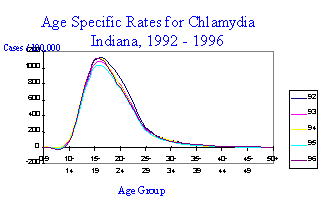
[an error occurred while processing this directive]
GONORRHEA
Cases = 6,458
Crude Rate (per 100,0000) =116.5
Sex-specific rates:
Female = 113.1
Male = 120.0
Race-specific rates:
Black = 1030.4
White =24.3
Other = 62.6 (32 cases)
Following the national trend, Indiana experienced a reduction in the number of gonorrhea cases in 1996. Indiana’s caseload decreased by 30% (6,458 cases in 1996, 9,224 cases in 1995). Gonorrhea-1 shows the gonorrhea case rate by age group for 1996.
Gonorrhea-1

Persons in the 15-19 year old age group experienced the largest case rate decrease when compared to other age groups. In 1993, persons aged 15-19 had an age-specific gonorrhea case rate of 808 per 100,000 population. The rate decreased to 508 cases per 100,000 in 1996.
Gonorrhea-2 shows the gonorrhea rate by metropolitan areas for three of the cities with the highest incidence: Ft. Wayne, Gary and Indianapolis. Although these cities comprise only 28% of the state’s population, they accounted for 71% of the reported cases in 1996.
Gonorrhea-2
Rates of Reported Gonorrhea Cases
Three Highest-Incidence Cities
Indiana, 1996
|
City |
Number of cases Cases/100,000
|
|
Fort Wayne |
676 225
|
|
Gary |
469 99
|
|
Indianapolis |
3,409 428
|
Very few cases of penicillinase-producing Neisseria gonorrhoeae (PPNG) cases were reported prior to 1989. Gonorrhea-3 illustrates the annual number of gonorrhea cases in the state from 1992 to 1996, and the proportion of isolates tested that were PPNG. In 1990, all public STD clinics in Indiana, as well as family planning clinics began to treat gonorrhea with non-penicillin regimens. The decrease in the proportion of PPNG isolates may reflect this change in treatment.
Gonorrhea-3

EARLY SYPHILIS
Cases = 472
Crude Rate (per 100,000) = 8.5
Sex-specific rates:
Female = 9.4
Male = 7.6
Race Specific rates:
Black = 39.4
White = 0.5
Syphilis-1 shows the number of early syphilis cases reported by month in 1992-1996. There were 36% fewer early syphilis cases reported in 1996 than in 1995 (472 vs. 732) Intervention methods employed in Ft. Wayne, Indianapolis and in Lake county are likely contributing to the decrease in syphilis cases.
Syphilis-1

Syphilis-2 depicts age-specific rates for early syphilis in 1992-1996. Decreases in morbidity for all age groups is apparent. Although early syphilis morbidity has decreased from 1992 levels, the 15-19 year age group shows the least improvement from the 1992 rates. This suggests that early syphilis infections continue to disproportionately affect the 15-19 year age group.
Syphilis-2

CHLAMYDIA
Cases = 10,100
Crude rate (per 100,0000) = 182.2
Sex-specific rates:
Female = 293.7
Male = 63.7
Race-specific rates:
Black = 889.7
White = 83.0
While Chlamydia trachomatis has been known to cause sexually transmitted genital infections for a number of years, only recently have economical and practical diagnostic methods been available to the physician. This enables the clinician to appropriately identify and treat patients, and has led to more accurate reporting of the disease. The medical community now realizes the widespread nature and potentially serious consequences of untreated chlamydia which may lead to pelvic inflammatory disease (PID) and sterility in women. Chlamydia case rates are the result of combination of factors including more sensitive diagnostic methods, more people being tested in the population, as well as a real increase in disease. As more persons are tested, more cases are discovered.
The graph on the next page summarizes age-specific rates for chlamydia infection for 1992-1996. The graph demonstrates the highest rate of chlamydia for the past four years in the 15-19 and 20-24 year age groups.

There is a higher prevalence of chlamydia in females. However, these data must be interpreted with caution, since chlamydia screening programs preferentially test females. Chlamydia infection in males is often diagnosed as non-gonoccocal urethritis, which is not reportable. This leads to an underestimation of chlamydia morbidity in males.
Back to Table of Contents